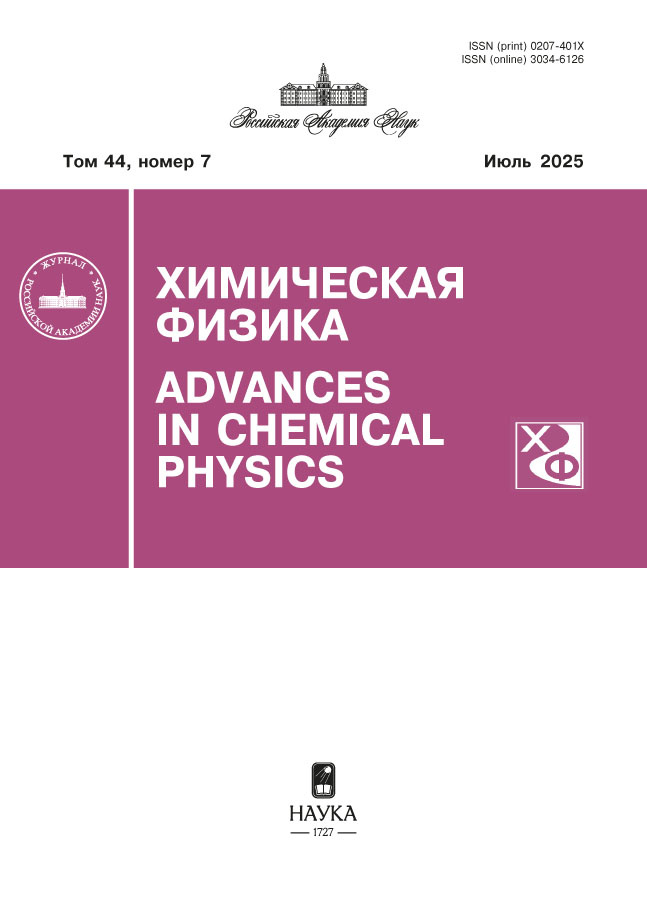Effect of Propane Additives on Laminar Burning Velocity in Hydrogen-Air-Water Steam Mixtures
- Autores: Krivosheev P.N.1, Kisel Y.S.1
-
Afiliações:
- Lykov Heat and Mass Transfer Institute of the National Academy of Sciences of Belarus
- Edição: Volume 44, Nº 7 (2025)
- Páginas: 43-53
- Seção: Combustion, explosion and shock waves
- URL: https://journals.eco-vector.com/0207-401X/article/view/687600
- DOI: https://doi.org/10.31857/S0207401X25070058
- ID: 687600
Citar
Texto integral
Resumo
A numerical simulation was conducted to investigate the laminar flame speed in a stoichiometric mixture of hydrogen, air, and water vapor, with the addition of a small amount of propane, at an initial temperature of 323 K and a pressure of 1 atm. The results demonstrate that even at low concentrations, propane acts as an effective inhibitor of combustion processes in hydrogen mixtures. A sensitivity analysis was performed, identifying the key chemical reactions that influence the formation of the laminar flame speed. Furthermore, application of Le Chatelier’s principle revealed that even minor additions of propane can substantially alter the mixture composition, specifically its overall fuel equivalence ratio, which may also affect the flame speed.
Texto integral
Sobre autores
P. Krivosheev
Lykov Heat and Mass Transfer Institute of the National Academy of Sciences of Belarus
Autor responsável pela correspondência
Email: krivosheyev.pavlik@gmail.com
Belarus, Minsk
Yu. Kisel
Lykov Heat and Mass Transfer Institute of the National Academy of Sciences of Belarus
Email: krivosheyev.pavlik@gmail.com
Belarus, Minsk
Bibliografia
- Hu Q., Zhang X., Hao H. // Int. J. Hydrogen Energ. 2023. V. 48. № 36. P. 13705. https://doi.org/10.1016/j.ijhydene.2022.11.302
- Bentaib A., Meynet N., Bleyer A. // Nucl. Eng. Technol. 2015. V. 47. № 1. P. 26. https://doi.org/10.1016/j.net.2014.12.001
- Babushok V., Tsang W. // Combust. and Flame. 2000. V. 123. № 4. P. 488. https://doi.org/10.1016/S0010-2180(00)00168-1
- Baldwin R.R., Corney N.S., Precious R.M. // Nature. 1952. V. 169. P. 201. https://doi.org/10.1038/169201b0
- Miller D.R., Evers R.L., Skinner G.B. // Combust. and Flame. 1963. V. 7. P. 137. https://doi.org/10.1016/0010-2180(63)90171-8
- Azatyan V.V., Namoradze M.A. // Combust. Explo. Shock Waves. 1973. V. 9. P.74. https://doi.org/10.1007/BF00740363
- Romanovich L.B., Azatyan V.V. // Russ. Chem. Bull. 1973. V. 22 P. 719. https://doi.org/10.1007/BF00857036
- Denisov E.T. // Russ. Chem. Rev. 1973. V. 42. № 3. P. 157. https://doi.org/10.1070/RC1973v042n03ABEH002572
- Katsitadze M.M., Dzotsenidze Z.G., Museridze M.D. et al. // React. Kinet. Catal. Lett. 1978. V. 9. P. 119. https://doi.org/10.1007/BF02068910
- Zamashchikov V.V., Bunev V.A. // Combust. Explo. Shock Waves. 2001. V. 37. P. 378. https://doi.org/10.1023/A:1017880308455
- Azatyan V.V., Pavlov V.A., Shatalov O.P. // Kinet. Catal. 2005. V. 46. P. 789. https://doi.org/10.1007/s10975-005-0137-1
- Azatyan V.V., Borisov A.A., Merzhanov A.G. et al. // Combust. Explo. Shock Waves. 2005. V. 41. P. 1. https://doi.org/10.1007/s10573-005-0001-7
- Bunev V.A. // Combust. Explo. Shock Waves. 2006. V. 42. P. 367. https://doi.org/10.1007/s10573-006-0064-0
- Azatyan V.V., Kalachev V.I., Masalova V.V. // Kinet. Catal. 2006. V. 47. P. 481. https://doi.org/10.1134/S0023158406040021
- Bunev V.A., Babkin V.S. // Mendeleev Commun. 2006. V. 16. № 2. P. 104. https://doi.org/10.1070/MC2006v016n02ABEH002270
- Rubtsov N.M., Azatyan V.V., Baklanov D.I. et al. // Theor. Found. Chem. Eng. 2007. V. 41. P. 154. https://doi.org/10.1134/S004057950702008X
- Bunev V.A., Namyatov I.G., Babkin V.S. // Russ. J. Phys. Chem. B. 2007. V. 1. P. 537. https://doi.org/10.1134/S1990793107060048
- Azatyan V.V., Abramov S.K., Prokopenko V.M. // Dokl. Phys. Chem. 2012. V. 447. P. 216. https://doi.org/10.1134/S0012501612120020
- Bunev V.A., Bolshova T.A., Babkin, V.S. // Combust. Explos. Shock Waves. 2016. V. 52. P. 255. https://doi.org/10.1134/S0010508216030011
- Yang Zh., Zhao K., Song X. et al. // Int. J. Hydrogen Energ. 2021. V. 46. № 70. P. 34998. https://doi.org/10.1016/j.ijhydene.2021.08.035
- Shang Sh., Bi M., Zhang K. et al. // Int. J. Hydrogen Energ. 2022. V. 47. № 61. P. 25864. https://doi.org/10.1016/j.ijhydene.2022.06.012
- Shang Sh., Bi M., Zhang Z. et al. // Int. J. Hydrogen Energ. 2022. V. 47. № 60. P. 25433. https://doi.org/10.1016/j.ijhydene.2022.05.256
- Shang Sh., Bi M., Zhang Ch. et al. // Int. J. Hydrogen Energ. 2024. V. 50. P. 1234. https://doi.org/10.1016/j.ijhydene.2023.10.042
- Smith G.P., Golden D.M., Frenklach M. et al. http://combustion.berkeley.edu/gri-mech/
- Chemical-Kinetic Mechanisms for Combustion Applications, San Diego Mechanism web page, Mechanical and Aerospace Engineering (Combustion Research). University of California at San Diego. http://combustion.ucsd.edu
- Metcalfe W.K., Burke S.M., Ahmed S.S. et al. // Int. J. Chem. Kinet. 2013. V. 45. № 10. P. 638. https://doi.org/10.1002/kin.20802
- Babichev A.N. Fizicheskie velichiny. Spravochnik. Moscow: Energoatomizdat, 1991.
- Gel’fand, B.E. // Combust. Explos. Shock Waves. 2002. V. 38. P. 581. https://doi.org/10.1023/A:1020346719768
- Le Chatelier H. // Bull. Soc. Chim. Fr. 1898. V. 74. P. 483.
Arquivos suplementares















